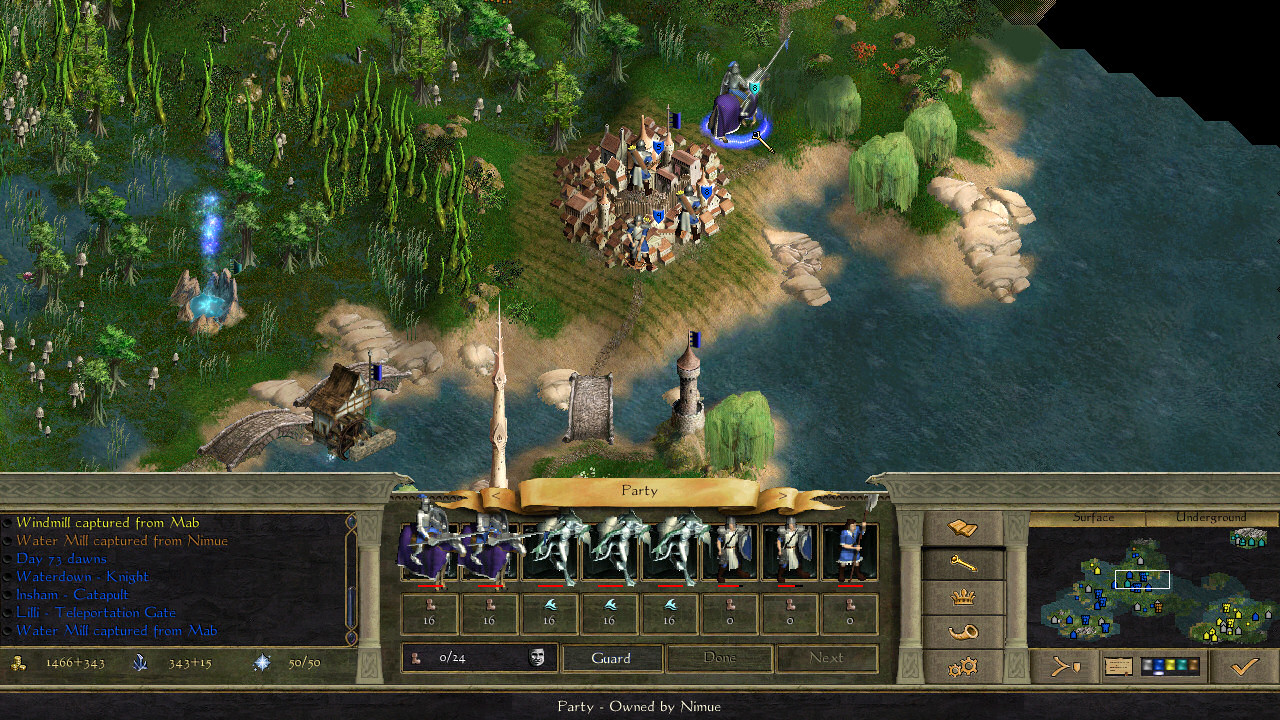Age of Wonders
Age of Wonders is a turn-based strategy video game often likened to Master of Magic. Originally titled World of Wonders, the game incorporated several role-playing video game elements that were dropped when simultaneous turns were implemented. The game was co-developed by Triumph Studios and Epic MegaGames, Dutch and American game developers respectively, and published by Gathering of Developers in 1999; it was re-released in 2010 on GOG.com and Steam. The game has three sequels, Age of Wonders II: The Wizard's Throne, Age of Wonders: Shadow Magic, and Age of Wonders III. The game has a single-player campaign, playable from two sides (more campaigns have been made by the community since release), and many maps, both included and user-created that can be played in Hotseat mode, over a LAN, on the Internet, or by email (PBEM). Up to 12 players can participate in a single game, depending on the map. Players have an isometric view of the map, which consists of hexagonal tiles, and can have up to three layers (surface, caverns, and depths). Units are arranged into groups (also known as parties or stacks) of up to eight units; a single such group occupies one tile. Cities occupy between one and four tiles, and other structures generally occupy a single tile. Each player leads a certain race. There are 12 races available in the game, though not all of them may be present on every map, and of those which are, not all may be playable. List of races includes traditional fantasy Elves, Lizardmen, Humans, Goblins, Dark Elves, Undead, Orcs, Dwarves and Halflings, as well as several unique ones such as Frostlings, Azracs, and Highmen. Races, as well as units not belonging to any specific race, such as dragons and giants, have a certain alignment, which can be good, neutral, or evil. According to their alignment and certain other factors, cities and independent units of one race can be friendly or hostile towards another race. This can manifest itself in different ways; for example, an orc city is not likely to surrender to the elves, and if conquered, may revolt unless there is a strong military presence in it to oppress the population. Units of hostile races forced to fight alongside each other in a single group will have lower morale, and are more likely to desert. Race relations can be improved by acts of goodwill towards other races, such as upgrading their cities, or hampered by razing, looting, or migrating cities belonging to that race. Diplomacy can also affect this and even an alliance with one race might affect the relation of another race. There are also several spells which have a global effect on race relations. There are two resources, gold and mana. Gold is used to build units, buy heroes, cities and spells (in Wizard Towers), upgrade cities. Mana is used to cast and research spells and use altars.
Age of Wonders
Worldwide
3.99€
4.99€ 20% OFF
You may also like these games
Game description
Age of Wonders is a turn-based strategy video game often likened to Master of Magic. Originally titled World of Wonders, the game incorporated several role-playing video game elements that were dropped when simultaneous turns were implemented. The game was co-developed by Triumph Studios and Epic MegaGames, Dutch and American game developers respectively, and published by Gathering of Developers in 1999; it was re-released in 2010 on GOG.com and Steam. The game has three sequels, Age of Wonders II: The Wizard's Throne, Age of Wonders: Shadow Magic, and Age of Wonders III. The game has a single-player campaign, playable from two sides (more campaigns have been made by the community since release), and many maps, both included and user-created that can be played in Hotseat mode, over a LAN, on the Internet, or by email (PBEM). Up to 12 players can participate in a single game, depending on the map. Players have an isometric view of the map, which consists of hexagonal tiles, and can have up to three layers (surface, caverns, and depths). Units are arranged into groups (also known as parties or stacks) of up to eight units; a single such group occupies one tile. Cities occupy between one and four tiles, and other structures generally occupy a single tile. Each player leads a certain race. There are 12 races available in the game, though not all of them may be present on every map, and of those which are, not all may be playable. List of races includes traditional fantasy Elves, Lizardmen, Humans, Goblins, Dark Elves, Undead, Orcs, Dwarves and Halflings, as well as several unique ones such as Frostlings, Azracs, and Highmen. Races, as well as units not belonging to any specific race, such as dragons and giants, have a certain alignment, which can be good, neutral, or evil. According to their alignment and certain other factors, cities and independent units of one race can be friendly or hostile towards another race. This can manifest itself in different ways; for example, an orc city is not likely to surrender to the elves, and if conquered, may revolt unless there is a strong military presence in it to oppress the population. Units of hostile races forced to fight alongside each other in a single group will have lower morale, and are more likely to desert. Race relations can be improved by acts of goodwill towards other races, such as upgrading their cities, or hampered by razing, looting, or migrating cities belonging to that race. Diplomacy can also affect this and even an alliance with one race might affect the relation of another race. There are also several spells which have a global effect on race relations. There are two resources, gold and mana. Gold is used to build units, buy heroes, cities and spells (in Wizard Towers), upgrade cities. Mana is used to cast and research spells and use altars.


